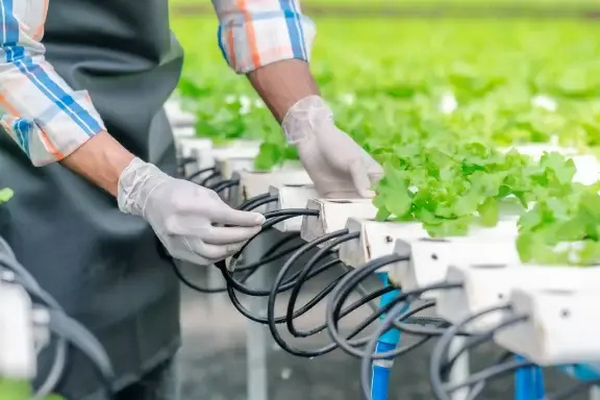The world of microbes is set to expand in 2025, as advancements occur for everyday growing practices. From inoculants and biologicals to beneficial microbes and even pathogens, the year ahead is all about embracing microbial innovation in greenhouses and hydroponics.
Explore these research highlights, each showcasing the incredible role of the microbiome in shaping sustainable agriculture.
The greenhouse Phyllosphere microbiome and bumblebees as vectors
Dr. Marie Legein and her team at the University of Antwerp explored the often-overlooked microbe ecosystems within hydroponic greenhouses. They found that bumblebees and predatory mites don't just help plants by pollinating or eating pests—they also carry bacteria with them. By identifying Snodgrasella and Gilliamella on both plants and bees, the team uncovered a new connection between pollination and microbial diversity. This breakthrough emphasizes the potential of biological interactions to enrich greenhouse microbiomes and boost plant health.
Learn more about this here.

How microbes live in hydroponic greenhouses with hairy root disease
Dr. Pablo Vargas and the team at KU Leuven took on the challenge of understanding the dynamics of microbes in hydroponic tomato greenhouses. By studying the bacteria in rockwool, they uncovered a tug-of-war between beneficial microbes like Paenibacillus and rhizogenic Agrobacterium, the cause of Hairy Root Disease. Their research highlighted the importance of microbial balance: greenhouses with a higher ratio of Paenibacillus were healthier and more productive. This points to new ways of using beneficial bacteria to address plant diseases and improve hydroponic farming practices.
Learn more about this study at the link here
Hydroponic rockwool, microbes, and root microbiome
Dr. Phil Thomas and the team at the University of New England explored the fascinating dynamics of the hydroponic microbes in rockwool and roots. Unlike soil, rockwool provides a clean slate where plants cultivate their microbial partners from scratch. The team uncovered opportunities to harness beneficial microbes for disease control and crop steering, noting that microbes like Trichoderma and Pseudomonas could play vital roles. Their research highlights the untapped potential of microbiome management in hydroponic systems, offering growers new ways to enhance plant health and yield.

Learn more about this study at the link here.
Hydroponic greenhouses and water microbes
Dr. Adeline Picot and the team at Université de Brest explored the hidden world of water microbes in hydroponic greenhouses. They discovered that water storage methods shape microbial communities: open tanks encouraged bacteria that thrive in oxygen-rich environments, while groundwater harbored microbes involved in nutrient cycling. By introducing biofiltration, the team demonstrated a way to reduce plant pathogens without harming beneficial microbes. Their work reveals how managing water microbiota can enhance greenhouse sustainability and disease prevention.
Learn more at the link here
Hydroponic plants dictate root microbe composition
Dr. Victor Lobanov and the team at the University of Gothenburg explored how plants shape their own microbial communities in soil-less systems. By growing lettuce in hydroponics and aquaponics, they discovered that plants act as gatekeepers, selecting specific microbes to form their rhizosphere communities. Even when upstream water or media were sterilized, the plants determined which microbes thrived near their roots. This research reveals how plants, not just their environments, drive microbial diversity in hydroponic farming, paving the way for targeted microbiome management to enhance crop productivity.
Learn more about this study at the link here
The microbes, hydroponic lettuce and phytophthora
Dr. Liese Vlasselaer and the team at KU Leuven delved into the microbial dynamics of hydroponic lettuce, focusing on how infection by Phytophthora cryptogea reshapes the plant's microbiome. They discovered that infected plants attracted higher numbers of beneficial bacteria like Pseudomonas and Flavobacterium, which could play a role in mitigating disease effects. This fascinating "cry-for-help" response by plants demonstrates how microbiomes adapt under stress, paving the way for new biocontrol strategies to protect hydroponic crops against devastating pathogens.

Learn more about this study at the link here
The six studies reviewed here underscore the pivotal role that microbiomes play in shaping the future of sustainable agriculture. From understanding how pollinators like bumblebees and mites carry beneficial bacteria, to revealing the dynamic microbial shifts in hydroponic systems, these findings highlight the complex yet powerful relationships between plants, microbes, and their environments.
Across diverse studies, researchers have shown how plants influence their microbial communities, often selecting microbes that enhance growth or combat disease. Beneficial genera like Paenibacillus, Pseudomonas, and Flavobacterium consistently emerge as key players, offering insights into biocontrol and plant health promotion. At the same time, advances in filtration and water microbiota management reveal practical ways to suppress pathogens like Phytophthora and Agrobacterium without compromising microbial diversity.
Together, these breakthroughs point to a transformative approach to agriculture where microbial ecosystems are actively managed and optimized. By steering microbiomes in hydroponic and greenhouse systems, growers can improve disease resistance, nutrient uptake, and overall crop resilience. As agriculture moves forward, integrating these findings into everyday growing practices promises a future of healthier plants, reduced chemical reliance, and more sustainable farming.
Source: Healthy Hydroponics
For more information:
Healthy Hydroponics
www.healthyhydroponics.ca
